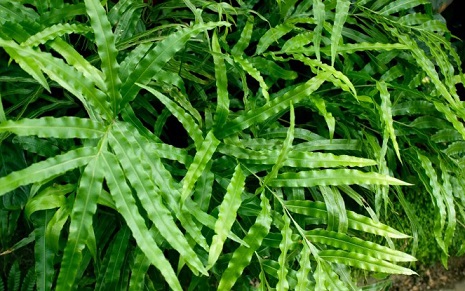Potential of Pteris medicinal plants in combatting COVID-19 and other viral diseases
Nikhil Prasad Fact checked by:Thailand Medical News Team Sep 16, 2024 7 months, 1 week, 3 days, 18 minutes ago
Herbs And Phytochemicals: A recent study explores the medicinal potential of five species of Pteris plants, traditionally used in herbal medicine, with a focus on their effectiveness against COVID-19. Conducted by researchers from the State Key Laboratory for Quality Ensurance and Sustainable Use of Dao-di Herbs, Institute of Medicinal Plant Development, Chinese Academy of Medical Sciences & Peking Union Medical College, and the Key Laboratory of Bioactive Substances and Resources Utilization of Chinese Herbal Medicine, this
Herbs And Phytochemicals news report delves into their findings. Using pharmaphylogenomics and network pharmacology, the study has provided intriguing insights into how these plants may offer new avenues for therapeutic development.
 Potential of Pteris medicinal plants in combatting COVID-19 and other viral diseases
Traditional Uses of Pteris Plants
Potential of Pteris medicinal plants in combatting COVID-19 and other viral diseases
Traditional Uses of Pteris Plants
Medicinal plants have long played an essential role in health care systems across the globe, particularly in traditional Chinese medicine (TCM). The Pteris genus is no exception, with five notable species - Pteris cretica, P. multifida, P. wallichiana, P. semipinnata, and P. vittate - being widely used to treat a range of conditions. These plants are known for their abilities to remove dampness, cool the blood, stop bleeding, reduce swelling, and even treat snake bites, hepatitis, and dysentery.
Despite these uses, the study sought to uncover the more complex molecular and chemical compositions of these plants, examining their potential to act against viral diseases, including COVID-19. The researchers employed sophisticated methods, including chloroplast genome analysis and network pharmacology, to explore the medicinal potential of these species.
Investigating the Genetic and Chemical Foundations
One of the key methods of this research involved the comparative analysis of the chloroplast genomes of the five Pteris species. Through this analysis, Pteris cretica and Pteris multifida were found to share a particularly close phylogenetic relationship. This connection extended to their chemical compositions and pharmacological properties, where similarities in active compounds between these species were observed.
The study used data visualization tools to generate protein-protein interaction networks and compound-disease target networks, which helped identify potential pathways these plants might influence. The functional annotations were further examined through Gene Ontology (GO) enrichment and the Kyoto Encyclopedia of Genes and Genomes (KEGG) pathway analyses.
Key Findings of the Study
This study’s findings unveiled a variety of potential therapeutic applications for the five species, particularly P. cretica. Out of the five, P. cretica was found to have the highest level of enrichment related to COVID-19 pathways. The chemical analysis revealed that P. cretica contains 21 active compounds, some of which were directly linked to COVID-19 treatment. Notable among these compounds were (
22E)-5α,8α-epidioxyergosta-6,22-dien-3β-ol, notholaenic acid, 2β,15α-diol-ent-kaur-16-ene, and multikaurane A.
In terms of potential mechanisms of action, P. cretica targets various virus infection pathways, including inflammatory response and immune modulation. Core pathways linked to P. cretica’s activity include the JAK-STAT signaling pathway, Toll-like receptor signaling, and more.
The study highlights how these pathways can play a significant role in combatting viral infections by regulating immune responses and preventing the virus from entering cells. This suggests that P. cretica could offer both preventative and therapeutic solutions for COVID-19 and other viral diseases.
Molecular Docking and COVID-19
One of the standout elements of this study was the molecular docking analysis, which tested the interaction between active compounds from P. cretica and various COVID-19 related proteins. Molecular docking revealed that several of these compounds showed strong binding affinity to SARS-CoV-2 proteins, such as the spike protein and the viral RNA-dependent RNA polymerase (RdRp). These are key proteins that the virus uses to replicate and infect human cells, making them critical targets for therapeutic intervention.
Among the most promising compounds was (22E)-5α,8α-epidioxyergosta-6,22-dien-3β-ol, which demonstrated significant binding potential to COVID-19-related proteins. This suggests that this particular compound could interfere with the virus’s ability to infect cells or replicate, positioning P. cretica as a potentially powerful anti-COVID-19 agent.
Implications Beyond COVID-19
The study did not limit itself to COVID-19. It also examined how these five plants might address other health conditions. P. cretica, for instance, showed potential in treating Alzheimer’s disease and cancer pathways, while P. multifida was linked to bladder cancer and Cushing syndrome pathways.
This broader therapeutic potential is promising, as it points to these plants being beneficial not just for viral infections but also for various chronic conditions. With their diverse chemical compositions and broad pharmacological activities, the five Pteris species may serve as versatile sources for drug discovery and development.
Conclusion: A New Frontier in Traditional Medicine
The study opens up exciting new possibilities for the use of traditional medicinal plants in modern therapeutic settings. By combining modern techniques like network pharmacology with centuries-old medicinal knowledge, the researchers have taken a significant step towards developing novel treatments for viral infections like COVID-19.
This research lays a solid foundation for future studies to delve deeper into the medicinal potential of P. cretica and related species. As more is uncovered, these plants may become essential in the global fight against pandemics and other health crises.
The study findings were published in the peer-reviewed journal Chinese Herbal Medicines.
https://www.sciencedirect.com/science/article/pii/S1674638424000844
For the latest on
Herbs and Phytochemicals, keep on logging to Thailand Medical News.
Read Also:
https://www.thailandmedical.news/news/flavonoid-glycosides-from-the-herb-viola-stocksii-shows-promising-therapeutic-properties-against-sars-cov-2-variants
https://www.thailandmedical.news/news/malaysian-researchers-discover-marantodes-pumilum-extract-as-a-potential-therapeutic-against-covid-19
https://www.thailandmedical.news/articles/herbs-and-phytochemicals
